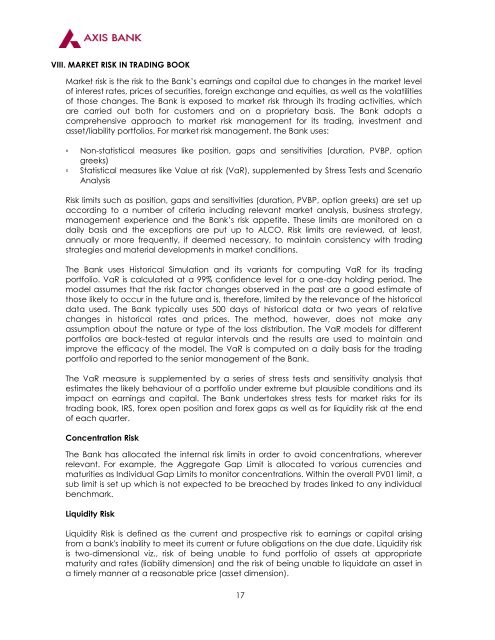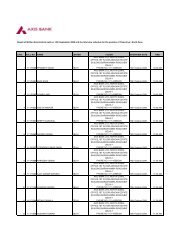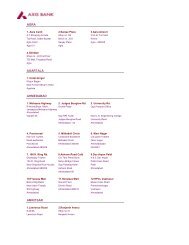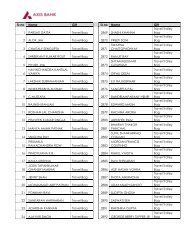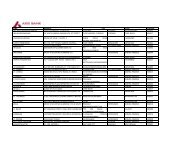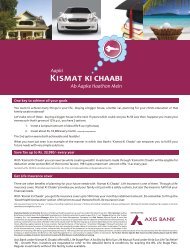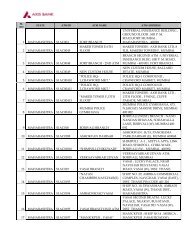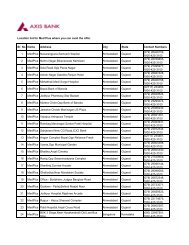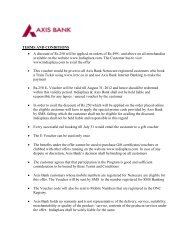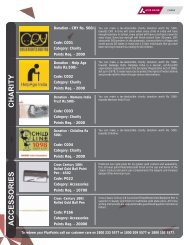Scope of Application
Scope of Application
Scope of Application
You also want an ePaper? Increase the reach of your titles
YUMPU automatically turns print PDFs into web optimized ePapers that Google loves.
VIII. MARKET RISK IN TRADING BOOK<br />
Market risk is the risk to the Bank‟s earnings and capital due to changes in the market level<br />
<strong>of</strong> interest rates, prices <strong>of</strong> securities, foreign exchange and equities, as well as the volatilities<br />
<strong>of</strong> those changes. The Bank is exposed to market risk through its trading activities, which<br />
are carried out both for customers and on a proprietary basis. The Bank adopts a<br />
comprehensive approach to market risk management for its trading, investment and<br />
asset/liability portfolios. For market risk management, the Bank uses:<br />
▫ Non-statistical measures like position, gaps and sensitivities (duration, PVBP, option<br />
greeks)<br />
▫ Statistical measures like Value at risk (VaR), supplemented by Stress Tests and Scenario<br />
Analysis<br />
Risk limits such as position, gaps and sensitivities (duration, PVBP, option greeks) are set up<br />
according to a number <strong>of</strong> criteria including relevant market analysis, business strategy,<br />
management experience and the Bank‟s risk appetite. These limits are monitored on a<br />
daily basis and the exceptions are put up to ALCO. Risk limits are reviewed, at least,<br />
annually or more frequently, if deemed necessary, to maintain consistency with trading<br />
strategies and material developments in market conditions.<br />
The Bank uses Historical Simulation and its variants for computing VaR for its trading<br />
portfolio. VaR is calculated at a 99% confidence level for a one-day holding period. The<br />
model assumes that the risk factor changes observed in the past are a good estimate <strong>of</strong><br />
those likely to occur in the future and is, therefore, limited by the relevance <strong>of</strong> the historical<br />
data used. The Bank typically uses 500 days <strong>of</strong> historical data or two years <strong>of</strong> relative<br />
changes in historical rates and prices. The method, however, does not make any<br />
assumption about the nature or type <strong>of</strong> the loss distribution. The VaR models for different<br />
portfolios are back-tested at regular intervals and the results are used to maintain and<br />
improve the efficacy <strong>of</strong> the model. The VaR is computed on a daily basis for the trading<br />
portfolio and reported to the senior management <strong>of</strong> the Bank.<br />
The VaR measure is supplemented by a series <strong>of</strong> stress tests and sensitivity analysis that<br />
estimates the likely behaviour <strong>of</strong> a portfolio under extreme but plausible conditions and its<br />
impact on earnings and capital. The Bank undertakes stress tests for market risks for its<br />
trading book, IRS, forex open position and forex gaps as well as for liquidity risk at the end<br />
<strong>of</strong> each quarter.<br />
Concentration Risk<br />
The Bank has allocated the internal risk limits in order to avoid concentrations, wherever<br />
relevant. For example, the Aggregate Gap Limit is allocated to various currencies and<br />
maturities as Individual Gap Limits to monitor concentrations. Within the overall PV01 limit, a<br />
sub limit is set up which is not expected to be breached by trades linked to any individual<br />
benchmark.<br />
Liquidity Risk<br />
Liquidity Risk is defined as the current and prospective risk to earnings or capital arising<br />
from a bank's inability to meet its current or future obligations on the due date. Liquidity risk<br />
is two-dimensional viz., risk <strong>of</strong> being unable to fund portfolio <strong>of</strong> assets at appropriate<br />
maturity and rates (liability dimension) and the risk <strong>of</strong> being unable to liquidate an asset in<br />
a timely manner at a reasonable price (asset dimension).<br />
17


